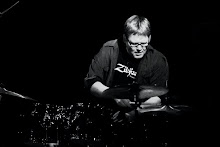Hey all.
Many students have mentioned to me Tommy Igoe's " Great Hands For a Lifetime " book so I decided to check it out, having worked through his first "Groove Essentials" book and quite enjoying it.
All in all, it's a very helpful book on rudimental playing, well written and presented. I don't agree with everything he writes, but having played drums for 44 years this coming fall, I rarely agree with anything ANYONE writes! :)
One thing that struck me during my first cursory glances was that he talks about converting the rudiments to drum set ideas, but doesn't really offer any method of doing so. I plan to cover this in greater depth and send as a possible article, but for now I thought I'd offer some general principles that help me make rudiments hipper and more useable on drum set. Okay here goes....
1. Corrupt the symmetry.....
I've mentioned this before, but one of the things that makes the rudiments seem very square is this " 4 on the right, 4 on the left" quality they have, due to trying to make the hands equal. This makes sense from a physical conditioning sort of way, but results in very predictable boxy, phrasing. So, a very easy way to create interest is to take away or add a note to any rudimental idea to make it odd numbers.
Let's take a paradiddle- RLRR LRLL, and take away the last stroke. Now we have a 7 note idea. Now when we play this idea in 8th notes or triplets, it will go over the carline and give us some really cool textures.
Now, how about we add a note- RLRR LRLLL . This create a cool 9 beat idea. Again, it will go over the barline in 4/4 or it WILL fit into a bar of 3/4 as triplets, but that could also be cool as we spread out the hands between two surfaces so it could be used in a jazz waltz or a afro-cuban 9/8 groove.
2. Orchestrate!
As I just mentioned, our lowly paradiddle starts to sound more interesting not only with a note missing or added, but also as we put our hands to 2 different drum or cymbals surfaces. Here's just a few ways we can create interesting tonal ideas from RLRR LRLL
a) R on Hi-Hat, L on snare
b) " "", L on rim click
c) "" , L on small tom
d) "" , L on floor tom
e) "" , L on any combination of above
f) R on floor tom, L any combination of above
g) R on Ride Cymbal, L ""
h) R on any rim, "" ""
Phew! And I just said I was going to mention a few. Anyway, check out how these different combinations sounds and don't be afraid to experiment with any possible sounds. You'll likely find you discover some favourites. Good!
3. Change the home rhythmic grid.
We've already seen that we can change any 8th note idea to triplets to make it more compelling, and the opposite ie true as well. We can also, however, change any idea to an odd grouping, and that really starts to sparkle!
If we again take RLRR LRLL and play it as 2 sets of quintuplets in a bar of 4/4, the quintuplets themselves don't go over the barline, but the sticking does! This sounds really cool, especially when we again orchestrate the hands. In fact, a favourite exercise of mine with "Stick Control" is to take the first 3 pages and play the stickings as quintuplets, septuplets, and groupings of 9, all in 4/4. That's definitely something you'll never hear a drum corps play! :)
4. Change the attack
Now let's take RLRR LRLL and....
a) Buzz the first L
b) Buzz all Ls
c) Deadstroke the first and 5th notes
d) Deadsroke all Rs
So, here all we're doing is not playing all the notes as regular strokes, and again this creates interest.
5. Add accents, especially in unusual places
Take the paradiddle and accent other notes the than the first set of each 4 ( the standard way ) and you'll get some very cool textures, especially accenting either the first or second note of a double. This is also great for your hands!
6. Substitute feet for hands in a portion of the lick
Some possible ways to evolve the feel in our paradiddle
a) RF L RR LF R LL
b) RF LRR LRLL
c) R LF RR LF R LL
d) RL RF RF LR LF LF
So, plenty of linear trouble was can get into with this one.
Obviously, working on rudiments and rudimental ideas ( I make that distinction because although paraddiles are a great lick and a great example to use, I actually don't think of them as rudiments per se.) are a great way of helping us create quality sounds, but to a drum set player, they are just the beginning and a mere means to an end. So, don't be afraid to take these building blocks and do something creative. That's what it's all about.
Subscribe to:
Post Comments (Atom)

No comments:
Post a Comment